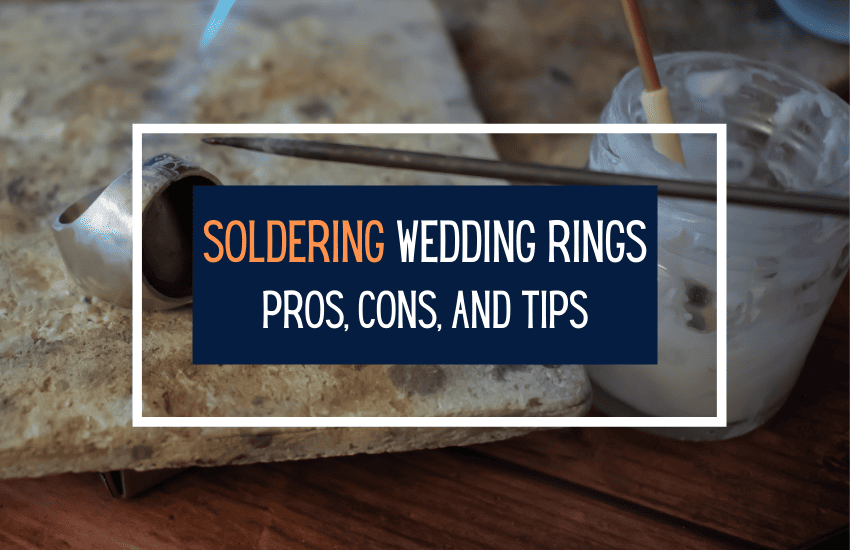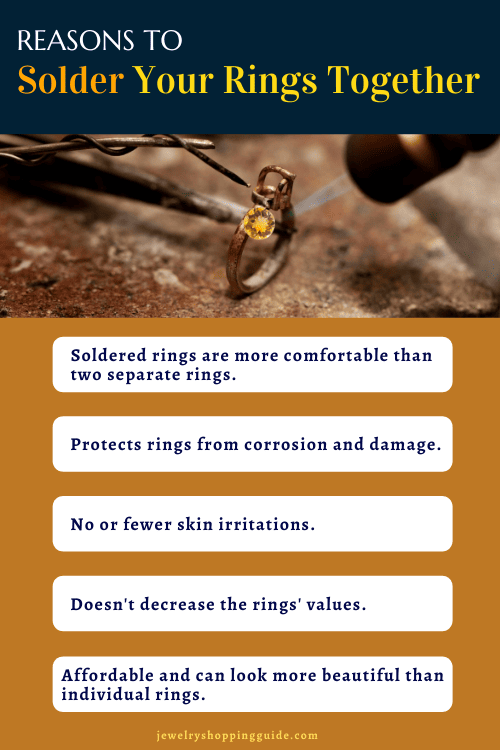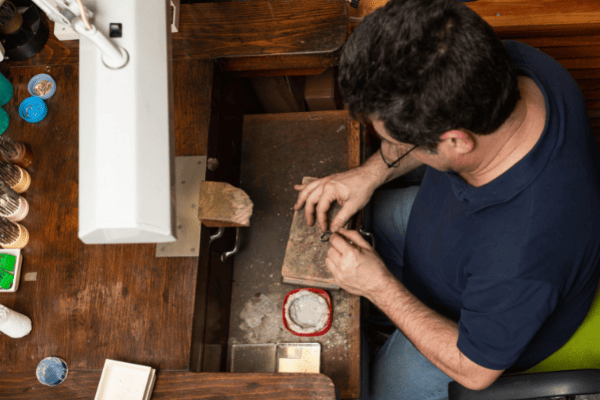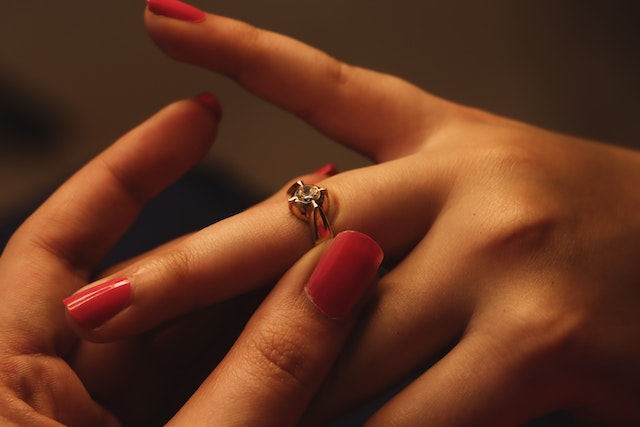
Table of Contents
Engagement and wedding rings are two different but very beautiful traditions in their own rights. One symbolizes the promise two people give each other and the other represents their eternal and inseparable bond. A wedding ring isn’t meant to “replace” an engagement ring nor to be “better” than it – they are both gorgeous representations of two of the most memorable moments of a couple’s life together.
These two rings are also physical objects, however, and as such, they require quite a bit of care. If you want to wear them on the same finger, two rings can cause some skin irritations, they can knock and scratch each other, and can lead to increased ring corrosion as well.
So, this leads many to do something pretty interesting with their engagement and wedding rings. This is to fuse the two rings together into one ring.
Why solder an engagement ring and a wedding band together?
Soldering engagement and wedding rings isn’t an overly popular practice but it is done by quite a lot of people. It sounds like a rough process but a professional jeweler will actually be quite careful with it – they’ll melt a separate piece of metal of the same color and type as that of your rings, and they’ll use that metal to connect the two rings without actually damaging or melting them.
Soldering two rings in such a way has quite a lot of benefits as well as a couple of drawbacks you should keep in mind.
Pros Of Soldering Your Rings
Soldering rings has become extremely popular. Aside from the simplicity and low cost of the process, there are several practical reasons why it’s the best thing to do.
1. Soldered rings feel more comfortable than two separate rings.
Many people wear their engagement rings and wedding bands on separate fingers as it often feels uncomfortable to have both next to each other. Even when you do that, however, the two rings can still feel uncomfortable, as they can still knock and harm, each other, and so on.
Soldering the two solves this issue as it essentially turns them into a single, larger ring. This means no more pinching your skin between them, no more sliding in random opposite directions, and an overall much more comfortable feel.
2. Soldering protects your rings from corrosion, damage, and general wear and tear.
Whether you wear the two rings on the same finger or on two fingers, they will almost always hit and knock each other from time to time. You can space them with a finger – wear one on your pinky and one on your middle finger, or one on your index finger and one on your ring finger, but most people dislike either of those options.
Soldering the two rings together and wearing them both on your ring finger that way is a great way to ensure that they will never again knock or scratch each other and that you’ll minimize the ring corrosion on both of them.
3. No or fewer skin irritations.
Even aside from the occasional skin pinching that can occur by wearing to fingers, more significant skin irritations are also an option. The constant sliding and moving of two unconnected rings can even cause unexpected and frustrating rashes. However, if you fuse the two together, they typically feel much better on the skin and don’t cause nearly as many problems.
4. There isn’t much risk of damaging the rings during the process, as long as you’ve hired a professional and experienced jeweler.
Soldering rings feels like a harsh and messy process but an experienced craftsman can do the whole thing with nearly ~0% risk for the rings. We can’t give any guarantees, as it all depends on who you entrust your rings too, but a good professional should be able to solder your rings without causing them any real damage. It is the additional intermediate piece of metal that gets melted and that fused the two together so that the two rings can remain unharmed.
5. The soldering process doesn’t decrease the rings’ values.
Many people love getting quite high-value and luxurious rings for their loved ones, so soldering two such rings can feel like a waste of the investment. That isn’t really the case, however. As an experienced professional can solder two rings without damaging them, the value of the rings isn’t really decreased – if anything, it’s combined. Of course, you won’t be able to sell them separately anymore, but both their metals and gemstones will retain all their value.
6. Depending on the designs of the separate rings, the end result of the soldering can look quite stunning.
Not all ring designs work well together, but engagement and wedding rings are usually chosen to complement each other. Even if you didn’t plan on soldering them when you bought them, you likely still meant for them to be worn together.
So, fusing two such rings into a single piece can sometimes help them look even more impressive. In fact, with a bit of forethought, you can pick both rings so that they can look even better when you solder them later on.
7. It is quite a romantic thing to do.
At the end of the day, both engagement and wedding rings are first and foremost meant to symbolize two people’s love for each other. And even if you’re soldering them together for any of the purely practical reasons above, the procedure is quite romantic too. It can symbolize two coming together as one.
8. Soldering two rings together is surprisingly affordable.
You’d think that such a procedure costs a lot of money, but it can literally be just a 2-digit sum at your local jewelry sum. Even if the two rings have complex designs, or you’re looking for a more innovative soldered design, or if you want to work with a more high-profile jeweler, the price would typically still remain in the low hundreds.

Cons Of Soldering Your Rings
Despite some very real positives to having your engagement and wedding ring soldered together, there are some negatives that you should consider. These may convince you that keeping them separate is the way to go.
1. Fit can be a problem
Two slim rings on your finger will move around with a degree of flexibility and freedom, as per their function when you had them sized and fitted.
But soldering those two rings together makes them – in essence – one wide ring, and the movement on your finger will be reduced in relation to this change.
It shouldn’t be a huge problem but can occasionally make for an uncomfortable and restricted fit.
2. The appearance of your ring may be an issue
As with fit, rather than having two slim rings on your finger, you’ll now have one relatively wide ring.
It’ll look wider and potentially more cumbersome and may not sit on your finger with quite the same pleasing balance as two separate rings.
Additionally, your two rings were not originally designed to be soldered together, so the contrast in appearance between the two may be an issue, especially if two metals (gold and silver, for example) have been employed in two rings.
3. They can’t easily be separated again
Another negative factor is that, without expensive and potentially harmful procedures to separate your two rings again, once the rings are soldered together, they are meant to stay that way forever. Yes, the change can be reversed, but the potential damage to your rings is a risk.
4. Soldered rings may not be life-practical
Depending on where you work and what you do, it may not be appropriate to wear two rings soldered together. If it’s likely to cause a problem, and if you’re certain only your wedding ring should be on display, then don’t get them soldered.
Additional Tips to Consider

Whether you’ve made up your mind on soldering your rings or you’re still wondering, there are a few other things you should consider too. These aren’t as much pros or cons as they are just things to keep in mind.
1. It’s a good idea to resize both rings before soldering them together.
Even if both your rings fit your fingers well right now and even if you’ve left a bit of leeway just in case, it’s still better to resize the rings before soldering them. That’s because the width of a ring affects how it feels on the finger. A thin ring can be slightly tighter while an extra wide ring can feel more constricting.
So, even if both rings feel right when worn on the same finger, soldering them together can make the rings more inflexible. Consult with a jeweler on exactly how much you should resize your rings to before soldering – it may be that they are already wide enough, but a professional needs to see them in person to say for sure.
2. The soldering process can actually take quite a bit of time so plan ahead.
Keep in mind that the soldering process can take up to 1-2 weeks or even more depending on how busy the jeweler is, whether the rings need to be resized first, how complex their designs and settings are, and so on.
So, if you’re in a hurry, say you want them soldered for your wedding day, for example, you should start the process ahead of time or leave it for a later date.
3. If you’re not sure about soldering, there are alternatives such as ring wires and connectors.
Soldering isn’t actually the only way to keep two rings together. Ring wires and connectors are also effective if all you’re interested in minimizing the physical discomfort of wearing two rings at the same time. Both of these methods are also temporary, harmless to the rings, even more affordable, and reversible.
Are There Alternative Options?
A non-permanent option is to use a ring wire to hold your two rings together. This may prove slightly cumbersome but is a good and inexpensive choice if soldering is out of the question, or even to check if soldering might be an option for you further down the line.
What’s The Difference Between Soldering and Fusing?

Soldering is, in essence, a kind of metal gluing process, with the solder (another metal) melted and used as a bonding agent to join the metals on the two rings together. Most precious metals, including gold and silver, can be soldered.
Fusing can only be achieved with ‘pure’ metals and is achieved by heating two touching rings to their melting point. Once they cool, they are attached. The process leads to a more natural-looking finish but is also more prone to errors and irregularity of finish.
Where Can I Get My Rings Soldered?
Most reputable jewelers will solder your rings, and while home kits are available, for a thorough job with a quality finish, getting the professionals to do it for you is the only way to go.
Should You Solder Your Rings Together?
At the end of the day, if the two rings work well together and if you don’t plan on using them separately, there isn’t much reason not to solder them into a single piece. Even just the protection from corrosion, skin irritations, and wear and tear you’d get is worth in many ways.
But, then again, there are alternatives and there are no rules or limitations on how you should wear your engagement and wedding rings. Some people even wear them on chains around their necks, so, the options are limitless.
FAQs About Soldering Your Rings
1. What is a soldered ring?
This is when two separate rings are soldered together to create a single bridal set.
2. How are rings soldered together?
A filler metal is heated, melted, and then used to fuse the two rings together.
3. How much does it cost to solder rings?
Soldering wedding rings can be as affordable as $45, depending on your jeweler.
4. What are the benefits of soldering your rings?
You can minimize the damage to the rings by reducing friction and require less maintenance for the metal over time. Some people find that soldered rings are more comfortable to wear and are more romantic due to the visual symbolism of two becoming one. This also reduces the spinning of rings.
5. When should you solder your rings?
Most prefer to solder their rings about a week after their wedding.
6. Can you resize soldered rings?
Resizing soldered rings will require the jeweler to take the two rings apart, resize them, and then resolder them. This can damage any embellishments in the original solder.
Wrapping Up
Ring soldering has become extremely popular in recent years. For many, the simplicity and lack of cost in the soldering process, completed professionally at most good jewelers, is the perfect answer to the problem of two-ring damage and discomfort.
While there are negatives to the outcome, including the inevitable creation of one wider ring and a potential lack of balance in the union of the two, for most people the pros outweigh the negatives.
If in doubt, a ring wire could be a temporary option to test whether you like the look and feel of two rings becoming one. But if erosion and discomfort are a big issue with two rings, soldering is probably the best way to go.









